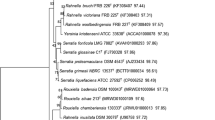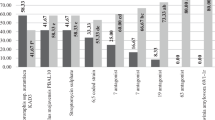Abstract
Lactic acid bacteria (LAB) can be a source of biological control agents (BCA) of fire blight disease. Several species of LAB are inhabitants of plants and are currently used as biopreservatives of food because of their antagonistic properties against bacteria, and are considered as generally safe. Candidates to BCA were selected from a large collection of LAB strains obtained from plant environments. Strains were first chosen based on the consistency of the suppressive effect against E. amylovora infections in detached plant organs (flowers, fruits and leaves). Lactobacillus plantarum strains PC40, PM411, TC54 and TC92 were effective against E. amylovora in most of the experiments performed. Besides, strains PM411, TC54 and TC92 had strong antagonistic activity against E. amylovora and also other target bacteria, and presented genes involved in plantaricin biosynthesis (plnJ, plnK, plnL, plnR and plnEF). The strains efficiently colonized pear and apple flowers; they maintained stable populations for at least 1 week under high RH conditions, and survived at low RH conditions. They were effective in preventing fire blight on pear flowers, fruits and leaves, as well as in whole plants and in a semi-field blossom assay. The present study confirms the potential of certain strains of L. plantarum to be used as active ingredient of microbial biopesticides for fire blight control that could be eventually extended to other plant bacterial diseases.





Similar content being viewed by others
References
Alakomi, H. L., Skytta, E., Saarela, M., Mattila-Sandholm, T., Latva-Kala, K., & Helander, I. M. (2000). Lactic acid permeabilizes Gram-negative bacteria by disrupting the outher membrane. Applied and Environmental Microbiology, 66, 2001–2005.
Aldwinckle, H. S., Bhaskara Reddy, M. V., & Norelli, J. L. (2002). Evaluation of control of fire blight infection of apple blossoms and shoots with SAR inducers, biological agents, a growth regulator, copper compounds, and other materials. Acta Horticulturae, 590, 325–331.
Alstchul, S. F., Gish, W., Miller, W., Meyers, E. W., & Lipman, D. J. (1990). Basic local alignment search tool. Journal of Molecular Biology, 215, 403–410.
Bringel, F., Quénée, P., & Tailliez, P. (2001). Polyphasic investigation of the diversity within Lactobacillus plantarum related strains revealed two L. plantarum subgroups. Systematics and Applied Microbiology, 24, 561–571.
Broggini-Schärer, G. A. L., Duffy, B., Holliger, E., Scharer, H. J., Gessler, C., & Patocchi, A. (2005). Detection of the fire blight biocontrol agent Bacillus subtilis BD170 (Biopro®) in a Swiss apple orchard. European Journal of Plant Pathology, 111, 93–100.
Cabrefiga, J., & Montesinos, E. (2005). Analysis of aggressiveness of Erwinia amylovora using disease-dose and time relationships. Phytopathology, 95, 1430–1437.
Cabrefiga, J., Bonaterra, A., & Montesinos, E. (2007). Mechanisms of antagonism of Pseudomonas fluorescens EPS62e against Erwinia amylovora, the causal agent of fire blight. International Microbiology, 10, 123–132.
Cabrefiga, J., Francés, J., Montesinos, E., & Bonaterra, A. (2011). Improvement of fitness and efficacy of a fire blight biocontrol agent via nutritional enhancement combined with osmoadaptation. Applied and Environmental Microbiology, 77, 3174–3181.
Cho, G. S., Huch, M., Hanak, A., Holzapfel, W. H., & Franz, C. M. A. P. (2010). Genetic analysis of the plantaricin EFI locus of Lactobacillus plantarum PCS20 reveals an unusual plantaricin E gene sequence as a result of mutation. International Journal of Food Microbiology, 141, S117–S124.
Cleveland, J., Montville, T. J., Nes, I. F., & Chikindas, M. L. (2001). Bacteriocins: safe, natural antimicrobials for food preservation. International Journal of Food Microbiology, 71, 1–20.
Di Cagno, R., Surico, R. F., Siragusa, S., De Angelis, M., Paradiso, A., Minervini, F., et al. (2008). Selection and use of autochthonous mixed starter for lactic acid fermentation of carrots, French beans or marrows. International Journal of Food Microbiology, 127, 220–228.
Diep, D. B., Havarstein, L. S., & Nes, I. F. (1996). Characterization of the locus responsible for the bacteriocin production in Lactobacillus plantarum C11. Journal of Bacteriology, 178, 4472–4483.
Giddens, S. R., Houliston, G. J., & Mahanty, H. K. (2003). The influence of antibiotic production and pre-emptive colonization on the population dynamics of Pantoea agglomerans (Erwinia herbicola) Eh1087 and Erwinia amylovora in planta. Environmental Microbiology, 5, 1016–1021.
Gomez, R., Muñoz, M., Ancos, B., & Cano, P. (2002). New procedure for the detection of lactic acid bacteria in vegetables producing antibacterial substances. Lebensmittel-Wissenschaft und-Technologie, 35, 284–288.
Holzapfel, W. H., Geisen, R., & Schillinger, U. (1995). Biological preservation of foods with reference to protective cultures, bacteriocins and food-grade enzymes. International Journal of Food Microbiology, 24, 343–362.
Ishimaru, C. A., Klos, E. J., & Brubaker, R. R. (1988). Multiple antibiotic production by Erwinia herbicola. Phytopathology, 78, 746–750.
Johnson, K. B., Stockwell, V. O., Sawyer, T. L., & Sugar, D. (2000). Assessment of environmental factors influencing growth and spread of Pantoea agglomerans on and among blossoms of pear and apple. Phytopathology, 90, 1285–1294.
Lane, D. J. (1991). 16S/23SrRNA sequencing. In E. Stackebrandt & M. Goodfellow (Eds.), Nucleic acids techniques in bacterial systematics (pp. 115–175). New York: Wiley.
Llop, P., Caruso, P., Cubero, J., Morente, C., & Lopez, M. M. (1999). A simple extraction procedure for efficient routine detection of pathogenic bacteria in plant material by polymerase chain reaction. Journal of Microbiology Methods, 37, 23–31.
McManus, P. S., Stockwell, V. O., Sundin, G. W., & Jones, A. L. (2002). Antibiotic use in plant agriculture. Annual Review of Phytopathology, 40, 443–465.
Mercier, J., & Lindow, S. E. (2001). Field performance of antagonistic bacteria identified in a novel laboratory assay for biological control of fire blight of pear. Biological Control, 22, 66–71.
Montesinos, E., & Bonaterra, A. (2009). Microbial pesticides. p. 110–120. In: M. Schaechter (Ed.), Encyclopedia of microbiology. Third edition. Elsevier Inc.
Mora, I., Cabrefiga, J., & Montesinos, E. (2011). Antimicrobial peptide genes in Bacillus strains from plant environments. International Microbiology, 14, 213–223.
Mundt, J. O., & Hammer, J. L. (1968). Lactobacilli on plants. Applied Microbiology, 16, 1326–1330.
Ngugi, H. K., Lehman, B. L., & Madden, L. V. (2011). Multiple treatment meta-analysis of products evaluated for control of fire blight in the eastern United States. Phytopathology, 101, 512–522.
Pujol, M., Badosa, E., & Montesinos, E. (2007). Epiphytic fitness of a biological control agent of fire blight in apple and pear orchards under Mediterranean weather conditions. FEMS Microbiology Ecology, 59, 186–193.
Pusey, P. L. (1997). Crab apple blossoms as a model for research on biological control of fire blight. Phytopathology, 87, 1096–1102.
Pusey, P. L. (1999). Laboratory and field trials with selected microorganisms as biocontrol agents for fire blight. Acta Horticulturae, 489, 655–661.
Pusey, P. L. (2002). Biological control agents for fire blight of apple compared under conditions limiting natural dispersal. Plant Disease, 86, 639–644.
Pusey, P. L., Rudell, D. R., Curry, E. A., & Mattheis, J. P. (2008). Characterization of stigma exudates in aqueous extracts from apple and pear flowers. Hortscience, 43, 1471–1478.
Pusey, P. L., Stockwell, V. O., & Mazzola, M. (2009). Epiphytic bacteria and yeasts on apple blossoms and their potential as antagonists of Erwinia amylovora. Phytopathology, 99, 571–581.
Remiger, A., Ehrmann, M. A., & Vogel, R. F. (1996). Identification of bacteriocin-encoding genes in Lactobacilli by polymerase chain reaction (PCR). Systematic and Applied Microbiology, 19, 28–34.
Ruiz-Barba, J. L., Cathcart, D. P., Warner, P. J., & Jimenez-Diaz, R. (1994). Use of Lactobacillus plantarum LPCO10, a bacteriocin producer, as a starter culture in Spanish-style green olive fermentations. Applied and Environmental Microbiology, 60, 2059–2064.
Sáenz, Y., Rojo-Bezares, B., Navarro, L., Díez, L., Somalo, S., Zarazaga, M., et al. (2009). Genetic diversity of the pln locus among oenological Lactobacillus plantarum strains. International Journal of Food Microbiology, 134, 176–183.
Shade, A., McManus, P. S., & Handelsman, J. (2013). Unexpected diversity during community succession in the apple flower microbiome. mBio, 4(2), e00602-12. doi:10.1128/mBio.00602-12.
Singh, A. K., & Ramesh, A. (2008). Succession of dominant and antagonistic lactic acid bacteria in fermented cucumber: insights from a PCR-based approach. Food Microbiology, 25, 278–287.
Smits, T. H. M., Rezzonico, F., Kamber, T., Goesmann, A., Ishimaru, C. A., Stockwell, V. O., et al. (2010). Complete genome sequence of Pantoea vagans plant-beneficial strain C9-1. Journal of Bacteriology, 192, 6486–6487.
Stockwell, V. O., McLaughlin, R. J., Hendels, M. D., Loper, J. E., Sugar, D., & Roberts, R. G. (1999). Epiphytic colonization of pear stigmas and hypanthia by bacteria during primary bloom. Phytopathology, 89, 1162–1168.
Sundin, G. W., Werner, N. A., Yoder, K. S., & Aldwinckle, H. S. (2009). Field evaluation of biological control of fire blight in the eastern United States. Plant Disease, 93, 386–394.
Tannock, G. W., Tisala-Timisjarvi, A., Rodtong, S., Ng, J., & Munro, K. (1999). Identification of Lactobacillus isolates from the gastrointestinal tract, silage and yoghurt by 16S-23S rRNA gene intergenic spacer region sequence comparisons. Applied and Environmental Microbiology, 65, 4264–4267.
Thomson, S. V. (1986). The role of the stigma in fire blight infections. Phytopathology, 76, 476–482.
Trias, R., Badosa, E., Montesinos, E., & Bañeras, L. (2008a). Bioprotective Leuconostoc strains against Listeria monocytogenes in fresh fruits and vegetables. International Journal of Food Microbiology, 127, 91–98.
Trias, R., Bañeras, L., Badosa, E., & Montesinos, E. (2008b). Bioprotection of Golden Delicious apple and Iceberg lettuce against foodborne bacterial pathogens by lactic acid bacteria. International Journal of Food Microbiology, 123, 50–60.
Trias, R., Bañeras, L., Montesinos, E., & Badosa, E. (2008c). Lactic acid bacteria from fresh fruit and vegetables as biocontrol agents of phytopathogenic bacteria and fungi. International Microbiology, 11, 231–236.
Vanneste, J. L., Cornish, D. A., Yu, J., & Voyle, M. D. (2002). P10c: a new biological control agent for control of fire blight which can be sprayed or distributed using honey bees. Acta Horticulturae, 590, 231–236.
Vermeirem, L., Devlieghere, F., & Debevere, J. (2004). Evaluation of meat born lactic acid bacteria as protective cultures for the biopreservation. International Journal of Food Microbiology, 96, 149–164.
Visser, R., Holzapfel, W. H., Bezuidenhout, J. J., & Kotzé, J. M. (1986). Antagonism of lactic acid bacteria against phytopathogenic bacteria. Applied and Environmental Microbiology, 52, 552–555.
Wilson, M., & Lindow, S. E. (1993). Interaction between the biological control agent Pseudomonas fluorescens A506 and Erwinia amylovora in pear blossoms. Phytopathology, 83, 117–123.
Yashiro, E., & McManus, P. S. (2012). Effect of streptomycin treatment on bacterial community structure in the apple phyllosphere. PLoS ONE, 7(5), e37131. doi:10.1371/journal.pone.0037131.
Acknowledgments
G. Roselló was recipient of a research grant BES-2010-035738 from Spain MINECO (Ministerio de Economía y Competitividad). Funding was provided by Spain MINECO (AGL2009-13255-c02-01 and AGL-2012-39880-C02-01) and FEDER of the European Union. The research group is under accreditation by SGR 2009-0812 and TECNIO net from Catalonia.
Author information
Authors and Affiliations
Corresponding author
Rights and permissions
About this article
Cite this article
Roselló, G., Bonaterra, A., Francés, J. et al. Biological control of fire blight of apple and pear with antagonistic Lactobacillus plantarum . Eur J Plant Pathol 137, 621–633 (2013). https://doi.org/10.1007/s10658-013-0275-7
Accepted:
Published:
Issue Date:
DOI: https://doi.org/10.1007/s10658-013-0275-7




